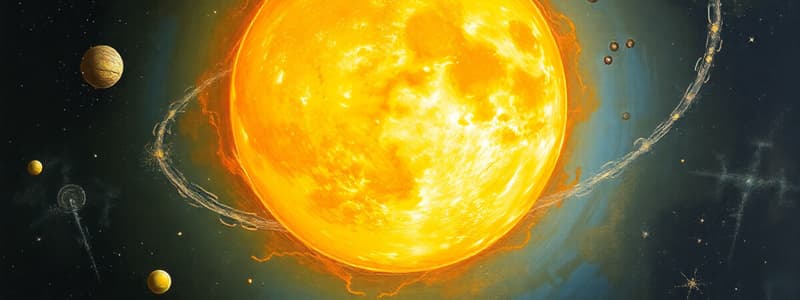Podcast
Questions and Answers
What celestial body is the largest Moon in our solar system?
What celestial body is the largest Moon in our solar system?
- Jupiter
- Uranus
- Saturn
- Ganymede (correct)
What predominantly rocky objects are found between Mars and Jupiter?
What predominantly rocky objects are found between Mars and Jupiter?
- Comets
- The Kuiper Belt
- Stars
- Asteroids (correct)
Which celestial body does the sun make up 98.8% of the mass?
Which celestial body does the sun make up 98.8% of the mass?
- The Earth
- The Solar System (correct)
- The Milky Way
- The Oort Cloud
There are many moons in our solar system.
There are many moons in our solar system.
Comets orbit the Sun.
Comets orbit the Sun.
Venus and Mercury have longer years than Earth.
Venus and Mercury have longer years than Earth.
The Earth's atmosphere is mostly composed of carbon dioxide.
The Earth's atmosphere is mostly composed of carbon dioxide.
How long does it take for sunlight to reach Earth?
How long does it take for sunlight to reach Earth?
What is the name of the largest volcano in our solar system?
What is the name of the largest volcano in our solar system?
What is the name of the closest star to Earth, besides the Sun?
What is the name of the closest star to Earth, besides the Sun?
How often does a Blue Moon occur?
How often does a Blue Moon occur?
What are the two types of telescopes?
What are the two types of telescopes?
Flashcards
Asteroid Belt
Asteroid Belt
Region with rocky objects between Mars and Jupiter.
Kuiper Belt
Kuiper Belt
Region of icy bodies beyond Neptune's orbit.
Oort Cloud
Oort Cloud
Distant spherical region of icy comet nuclei, source of long-period comets.
Comets
Comets
Signup and view all the flashcards
Ganymede
Ganymede
Signup and view all the flashcards
Age of the Sun
Age of the Sun
Signup and view all the flashcards
Venus and Mercury
Venus and Mercury
Signup and view all the flashcards
Mars
Mars
Signup and view all the flashcards
Planet Names
Planet Names
Signup and view all the flashcards
Milky Way
Milky Way
Signup and view all the flashcards
Mass of the Sun
Mass of the Sun
Signup and view all the flashcards
Types of Telescopes
Types of Telescopes
Signup and view all the flashcards
Apollo 11
Apollo 11
Signup and view all the flashcards
Neutron Star
Neutron Star
Signup and view all the flashcards
Black Hole
Black Hole
Signup and view all the flashcards
Supernova
Supernova
Signup and view all the flashcards
Andromeda Galaxy
Andromeda Galaxy
Signup and view all the flashcards
Earth's Spin Direction
Earth's Spin Direction
Signup and view all the flashcards
Distance from Sun
Distance from Sun
Signup and view all the flashcards
Earth's Atmosphere
Earth's Atmosphere
Signup and view all the flashcards
Sunlight to Earth
Sunlight to Earth
Signup and view all the flashcards
Proxima Centauri
Proxima Centauri
Signup and view all the flashcards
Moon's Atmosphere
Moon's Atmosphere
Signup and view all the flashcards
Moon's Orbit
Moon's Orbit
Signup and view all the flashcards
Moon's Visibility
Moon's Visibility
Signup and view all the flashcards
Phases of the Moon
Phases of the Moon
Signup and view all the flashcards
Blue Moon
Blue Moon
Signup and view all the flashcards
Study Notes
The Solar System
- The Asteroid Belt contains predominantly rocky objects between Mars and Jupiter.
- The Kuiper Belt consists of icy bodies beyond Neptune's orbit.
- The Oort Cloud is a distant, spherical region of icy comets.
- Comets are made of ice, dust and rock and do not orbit the Sun.
- The Sun is approximately 4.5 billion years old.
- Ganymede (a moon of Jupiter) is the largest moon in our solar system.
- Venus and Mercury have shorter years because they are closer to the Sun.
- Mars is the largest volcano in the solar system.
- Planet names are often based on Greek or Roman gods.
- The Sun accounts for 98.8% of the mass in the solar system.
Astronomy
- Refractor and Reflector are two types of telescopes.
- Apollo 11 was the first mission to the Moon.
- Supernova (exploding star) results from explosions.
- Core-collapse and thermal runaway supernovas exist.
Earth and the Moon
- Earth is about 150 million km from the Sun.
- Earth has a composition of 78% nitrogen and 21% oxygen in its atmosphere.
- Light from the Sun takes approximately 8 minutes to reach Earth.
- Proxima Centauri is the closest star to Earth; other than the sun.
- The Moon orbits Earth every 27 days and reflects sunlight.
- The Moon has 8 main phases in its cycle.
- A Blue Moon occurs when there are two full moons in one month.
- The Andromeda Galaxy is the nearest central galaxy to the Milky Way
- The distance between Earth and Andromeda is 2.5 million light years.
Studying That Suits You
Use AI to generate personalized quizzes and flashcards to suit your learning preferences.




